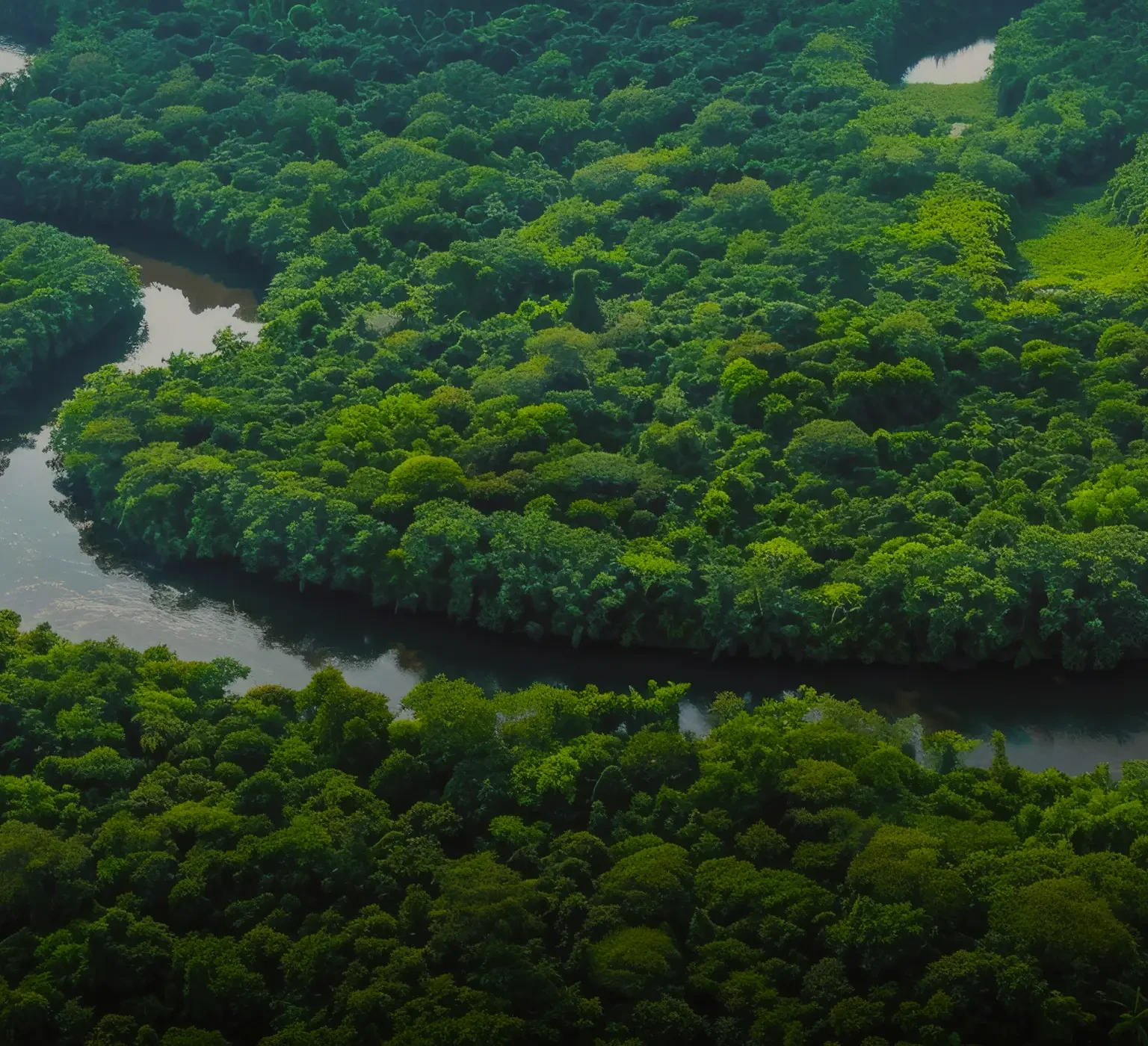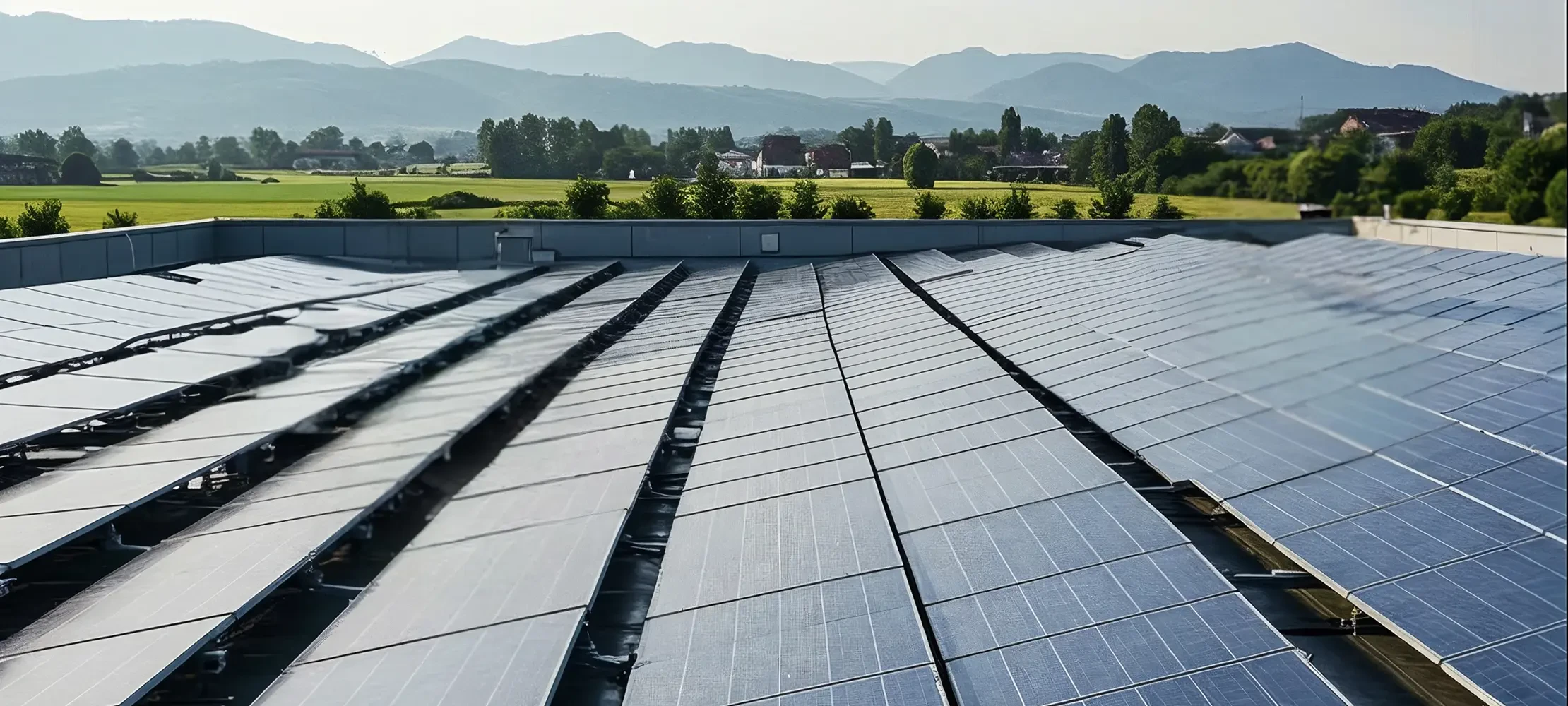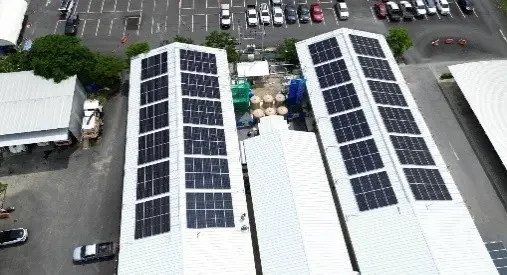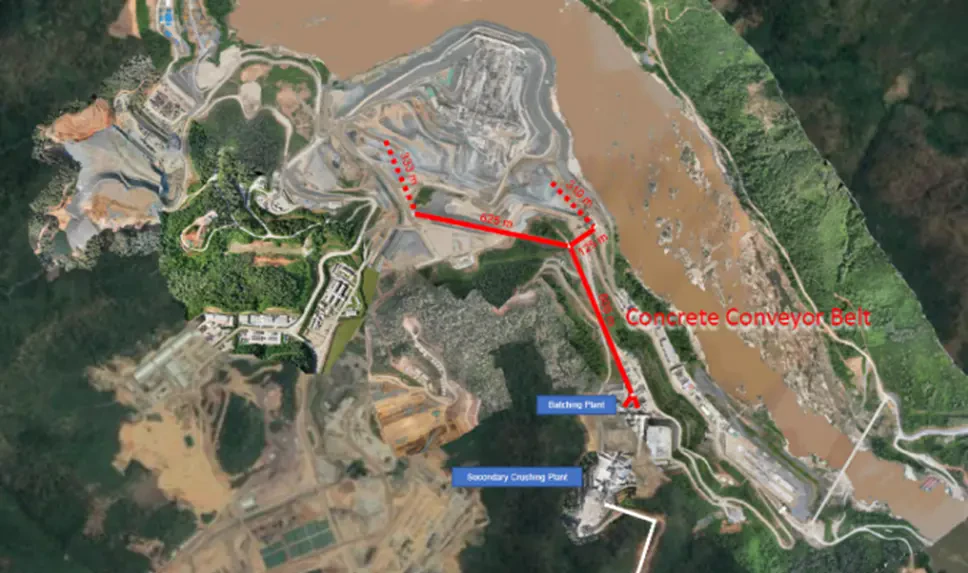

Energy and Climate Change
Commitment, Challenge and Opportunity
Climate change presents a significant global challenge that necessitates coordinated efforts across all sectors, including the construction industry. In alignment with the targets set by the Paris Agreement, reducing greenhouse gas emissions plays a crucial role in mitigating financial risks and adapting to evolving consumer expectations.
CH. Karnchang prioritizes sustainable business practices by implementing energy efficiency measures and reducing carbon emissions across its operations. These efforts support long-term corporate resilience while contributing to environmental preservation and sustainable development objectives.
CH. Karnchang is deeply committed to reducing the environmental and climate-related impacts of its business operations through the advancement of innovative business practices. This strategic approach mitigates long-term risks, including escalating operational costs, regulatory compliance challenges, and heightened market competition. Ineffective management practices may compromise public health, diminish quality of life, and exacerbate disaster vulnerabilities, while also impeding national climate objectives. By optimizing energy consumption and reducing greenhouse gas emissions, the company enhances cost efficiency, strengthens corporate reputation, and aligns with the evolving expectations of investors and stakeholders.
Supporting the SDGs Goals
Goal 7:
Goal 12:
Goal 13:

Stakeholders Directly Impacted
Goals and Performance Highlights
-
Achieve a 1% annual reduction in energy consumption.
Baseline Year (2020): 2,995,795 kWh, Long-Term Target for 2030

Management and Operational Approach
Energy Management

CH. Karnchang acknowledges and commits to the strategic significance of energy conservation and efficiency in mitigating operational risks associated with energy shortages, which directly contribute to escalating production costs and broader business challenges.
In response, the company has implemented a structured energy management framework, integrating energy efficiency optimization and the adoption of renewable energy solutions within its operations. Additionally, CH. Karnchang aligns with national energy conservation policies and promotes corporate-wide energy stewardship by cultivating awareness among employees on responsible energy consumption. These efforts contribute to cost reduction and operational sustainability while supporting the company’s broader environmental management agenda. This agenda encompasses sustainable green construction, climate resilience strategies, and biodiversity conservation, all of which are integral to CH. Karnchang’s long-term sustainability objectives.
Integration of Management Plans with Policies
Responsible Entities
Climate Change

CH. Karnchang is committed to addressing climate change through its environmental management policies, green construction practices, and sustainable biodiversity conservation. The company prioritizes sustainable resource utilization, pollution reduction, and effective climate risk management, aligning with the United Nations’ Sustainable Development Goals (SDGs). It has set an ambitious target to achieve Net-zero target for greenhouse gas emissions by 2065.
To reach this goal, CH. Karnchang integrates its investment strategies and operations with its long-term emissions reduction targets, in line with the Paris Agreement’s commitment to limiting global warming to 1.5°C. All initiatives are implemented under the Environmental, Social, and Governance (ESG) framework to drive long-term positive environmental and social impact. The company adheres to the ISO 14064-1 standard for greenhouse gas measurement, reporting, and reduction, as certified by the Thailand Greenhouse Gas Management Organization (TGO). Additionally, it actively incorporates advanced technologies and fosters stakeholder engagement to ensure sustainable business growth while maximizing value for all stakeholders. These initiatives underscore the company’s commitment to achieving its sustainability objectives and contributing to a greener future.
Climate Governance
To achieve net-zero carbon emissions by 2065, the company has established the Corporate Social Responsibility and Sustainability Management Committee and the Risk Management Committee. Responsibility for climate governance is shared among the Board of Directors, the Executive Committee, and senior management, with oversight from the Board of Directors, which is responsible for strategic planning and target setting. The Social and Sustainability Affairs Committee plays a key role in shaping and reviewing policies, monitoring progress, and assessing sustainability performance, including environmental management and climate change initiatives. Simultaneously, the executive team oversees corporate social and environmental responsibility projects, provides strategic recommendations, and supports relevant departments. In 2024, quarterly meetings were held, totaling four sessions, during which key decisions were made, including the approval of the Climate Risk Assessment.
Organizational Structure of Climate Governance
CH. Karnchang has established a management structure to address climate change. The company has assigned responsibility to the Corporate Social Responsibility and Sustainability Management Committee and the Risk Management Committee—comprising the Board of Directors, the Executive Committee, and senior management—to oversee and implement relevant initiatives. Each level has specific duties and responsibilities as follows:
| Roles | Duties and Responsibilities |
|---|---|
| Social and Environmental Enterprises | |
|
Board of Directors Consists of Dr. Pavich Tongroach Mr. Don Pramudwinai Dr. Supamas Trivisvavet Dr. Anukool Tuntimas |
|
|
Corporate Social Responsibility and Sustainability Management Committee Consists of Dr. Supamas Trivisvavet |
In 2024, the board of directors approved the implementation of an organizational carbon footprint assessment to measure and reduce greenhouse gas emissions from the company’s various activities. |
|
Climate Change Management Committee Consists of Mr. Nattavut Trivisvavet |
|
|
Corporate Social Responsibility and Sustainability Committee Consists of Mr. Sombat Trivisvavet Ms. Sawanya Trivisvavet |
|
| Corporate Governance and Risk Management. | |
|
Board of Directors Consists of Dr. Patarut Dardarananda Mr. Vitoon Tejatussanasoontorn Mr. Plew Trivisvavet Mr. Narong Sangsuriya Dr. Supamas Trivisvavet |
|
|
Corporate Governance and Risk Management Committee Consists of Dr. Patarut Dardarananda Mr. Vitoon Tejatussanasoontorn Mr. Plew Trivisvavet Mr. Narong Sangsuriya Dr. Supamas Trivisvavet |
|
|
Risk Management Committee Consists of Mr. Phongsarit Tantisuvanitchkul Mr. Sittidej Trivisvavet Dr. Anukool Tuntimas Mr. Watchara Sanghattawattana Mr. Pornnarong Siriyothin Mr. Prapon Chanpradubfa Mr. Pairat Prom-In Mr. Thammanoon Surarat Mr. Pichai Cheybumroong Mrs. Rinrada Tangtrongkid Mr. Wiboon Ungapipathanachai Mr. Keerati Luangchookiat Mr. Sombat Trivisvavet Mr. Thipwaree Athagrisna Mrs. Arunee Trivisvavet Ms. Sawanya Trivisvavet |
|
Climate Change Action
The company is committed to transparency in its climate change initiatives by aligning its disclosures to the guidelines of the Task Force on Climate-Related Financial Disclosures (TCFD) and prioritizing sustainable environmental management. Additionally, the company aims to reduce greenhouse gas emissions per unit of output and enhance resource efficiency through various ongoing initiatives. This includes assessing its organizational carbon footprint to develop strategic plans for reducing greenhouse gas emissions. In 2024, the company engaged Advance Energy Plus Co., Ltd. as a consultant, with validation conducted by Bureau Veritas (Thailand) Co., Ltd.. As part of this effort, the company will achieve ISO 14064-1:2018 certification and receive official certification from the Thailand Greenhouse Gas Management Organization in March and May 2025, respectively.
The greenhouse gas emissions (GHG) from business operations and activities.
| The greenhouse gas emissions (GHG) from business operations and activities. | 2023 | 2024 |
|---|---|---|
| Scope 1: Direct GHG emissions | 8,671.00 | 10,861.00 |
| Total Biogenic CO2 Emission | 395.00 | 645.00 |
| Scope 2: Indirect GHG emissions from energy use | 7,784.00 | 8,729.00 |
| Scope 3: Other indirect GHG emissions | 219,302.00 | 227,134.00 |
| Total | 236,152.00 | 246,724.00 |
Climate-Related Risk Management Procedures
In recognition of climate change, in 2024, CH. Karnchang conducted a Climate Change Risk Assessment in collaboration with its business partners. This study aimed to identify climate change-related risks (and opportunity) that could impact the business and the company’s operations, including both physical and transition risks. Examples of physical risks include rising average temperatures and increased rainfall, which may reduce construction productivity. The findings from this risk assessment will be integrated into CH. Karnchang business strategies, operational, and risk management plans to identify new opportunities and implement risk mitigation measures in both the short and long term. Additionally, the company will address a climate adaptation plan, integrating efforts across its risk management, business development, and sustainability teams. Governance oversight will be provided by the board of directors to enhance business resilience and maintain competitiveness. This approach also ensures alignment with stakeholder expectations, particularly those of investors. Furthermore, this initiative supports the goals of the Paris Agreement, aiming to limit global temperature increases to no more than 2°C. CH. Karnchang is aligning its efforts with the Nationally Determined Contributions (NDC).
Following the recommendations of the Task Force on Climate-related Financial Disclosures (TCFD), CH. Karnchang has identified five operational sites most vulnerable to climate-related risks across its value chain. These sites have been assessed for their physical and geographical characteristics using specialized risk assessment software. Key physical risks include heatwaves, sudden temperature drops, floods, thunderstorms, droughts, and wildfires. In terms of transition risks, significant challenges include regulatory and policy shifts, market dynamics, changing demand in the construction sector, and the growing impact of digital technology. The entire assessment process was conducted using scenario analysis based on the Shared Socioeconomic Pathways (SSP) framework, which evaluates factors such as population trends, economic growth, education, political developments, and technological advancements. The framework categorizes future scenarios into five possible pathways.
In its scenario analysis, CH. Karnchang evaluated 2 degree scenario in relation to business planning: A long term scenario where greenhouse gas emissions remain high or very high, with emissions nearly doubling by 2050. A long term scenario where greenhouse gas emissions are significantly reduced, ultimately reaching Net Zero by 2050. CH. Karnchang has identified key climate change risks and/or opportunities, both physical and transitional, integrating them into the company-wide risk management. Additionally, the company has outlined preliminary management strategies as follows:
| The Risks of Climate Change | The strategy to incorporate climate change risks and opportunities |
|---|---|
| Physical risk | |
|
Risk of Water Shortage CH. Karnchang must consider the risk of water shortages within its supply chain and among its business partners, as water is a crucial resource in the production of construction materials. A shortage could reduce the availability of materials, disrupting construction activities and potentially delaying projects. Such disruptions may undermine stakeholder confidence in the company’s ability to meet project deadlines. To maintain production standards, additional costs may arise from securing alternative water sources. Furthermore, reliance on natural water supplies carries risks, as these sources are shared by multiple industries and projects. Types of Risks
|
|
| Transition Risk | |
|
Changes in Laws and Carbon Pricing Changes in domestic laws and international cooperation are leading to the implementation of carbon taxation as a regulatory mechanism to mitigate the effects of climate change. If multiple countries adopt cross-border carbon pricing adjustments, such as the Carbon Border Adjustment Mechanism (CBAM), this could drive up construction material costs or cause delays in transportation when trading partners fail to meet the required standards or regulations. Types of Risks
|
|
|
Investment in Infrastructure The country’s current infrastructure investment presents a significant opportunity for CH. Karnchang, as much of the existing infrastructure still requires continuous development and improvement. The primary focus is on transportation systems, including roads, expressways (highways), rail systems, air travel, and ports. Additionally, this project has the potential to lead to further investment in sustainable finance options, such as Green Bonds and Green Loans. Types of Risks
|
|





